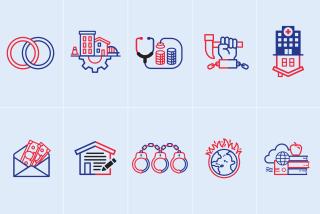School Bonds Revision Goes Before Voters : Education: Prop. 170 seeks a simple majority instead of two-thirds vote for approval. Supporters say it will relieve overcrowded classrooms. Others see it as a step toward undermining Prop. 13.
- Share via
SACRAMENTO — Facing bursting schools and a $30-billion construction backlog, Californians will be asked Nov. 2 to set aside a century-old state law that requires a two-thirds majority of local voters to approve the sale of bonds to finance construction of classrooms.
Proposition 170, a state constitutional amendment, is described by supporters as a necessary reform to relieve school overcrowding and give local voters a greater degree of control over their affairs.
But opponents see the measure as an alarming foot in the door for forces seeking to undermine Proposition 13, the landmark initiative that limited California property taxes.
The ballot measure, which would allow school bonds to be approved by a simple majority vote, is supported by a broad coalition of school officials, business and labor leaders, and the building industry. The organized opposition is led by the political heirs to the late Howard Jarvis, co-author of Proposition 13.
“This is about local control,” said Philip White, superintendent of Liberty Union High School District in Contra Costa County and a leader in the campaign for Proposition 170.
White and other backers of the proposal complain that the two-thirds majority needed to approve school bonds is too high a hurdle for many districts to overcome. The result, they say, is an overdependence on state bond measures, which are controlled by Sacramento, and on local building fees that drive up the cost of new housing.
More than half of the school bond measures on local ballots since 1986 have failed to win the required two-thirds majority, but more than nine out of 10 got a simple majority.
Both camps cite these numbers in attempts to bolster their arguments.
Proponents of Proposition 170 say it is unfair that a minority of local voters in so many cases has been able to thwart the will of the majority. Opponents counter that without the two-thirds requirement, local indebtedness would be much greater.
Whether good or bad for taxpayers, the result has been a shortage of school building funds at a time when enrollment in kindergarten through 12th grade has been growing at nearly 200,000 a year.
The state has stepped in, with voters passing statewide bond measures by majority votes every election year since 1982. A total of nearly $8 billion of state debt has been incurred on behalf of the schools. But the backlog persists.
Besides state bond money, the other source of revenue for school construction projects is developer fees, assessments slapped on builders when they obtain their permits and usually passed on to buyers of new homes. School districts can charge up to $2.65 per square foot for this purpose, or nearly $4,000 on a 1,500-square-foot home.
That explains why the building and real estate industries are among the strongest supporters of Proposition 170. Without new schools, new housing developments are stalled. And now, builders and their customers are footing much of the bill.
“There is an inseparable link between real estate and schools,” said Dwight Hansen, a lobbyist for the California Building Industry Assn.
Opponents argue that there also is a link between this proposal and Proposition 13, the politically sacred ballot initiative voters passed in 1978. The measure limited property taxes to 1% of assessed valuation and limited increases to 2% annually.
With property taxes in virtually every jurisdiction in the state at the 1% limit, local schools can no longer borrow the money they needed to build new schools.
“That effectively shut down locally financed school construction,” said Patrick McCallum, executive director of the Faculty Assn. of the California Community Colleges.
The law changed in 1986, when voters passed Proposition 46 to allow the 1% cap to be exceeded for the purchase of property or buildings--but only with the approval of two-thirds of local voters. This returned the law to the way it was for 100 years before Proposition 13.
Now, supporters of Proposition 170 want to go a step further, reducing the vote requirement on school bonds to a simple majority.
Defenders of Proposition 13 say they fear that lowering the vote for school bonds is only the first step in a pro-tax agenda that could lead to a repeal of the two-thirds vote requirement for special taxes that the initiative put in place.
“We think Proposition 13 is at stake,” said Joel Fox, president of the Howard Jarvis Taxpayers Foundation. “They are leading with the schools because that’s a top priority. But their intent is to take down the two-thirds vote requirement in Proposition 13.”
Fox said the two-thirds vote is a legitimate protection for property owners, who in many parts of the state would otherwise be vulnerable to having their taxes raised in elections dominated by renters, who do not pay property taxes.
“Only property owners pay these taxes,” Fox said. “The property taxpayers will be bearing this burden.”
But supporters of Proposition 170 say their only goal is to get needed schools built.
“This is not a Proposition 13 issue at all,” said Democratic Assemblyman Jack O’Connell of Carpinteria, whose efforts got the Legislature to put the measure on the ballot. “This will allow local communities to build schools to their own unique needs rather than to the fiscal limitations of the state.”
More to Read
Sign up for Essential California
The most important California stories and recommendations in your inbox every morning.
You may occasionally receive promotional content from the Los Angeles Times.










